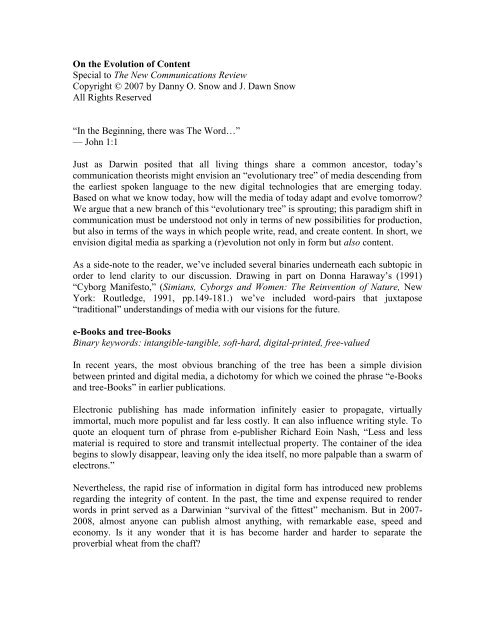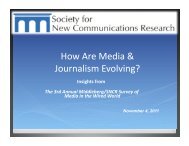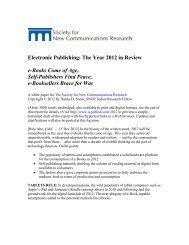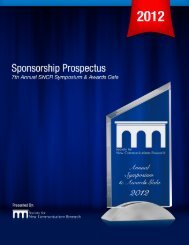Key points of conversation: - Society for New Communications ...
Key points of conversation: - Society for New Communications ...
Key points of conversation: - Society for New Communications ...
You also want an ePaper? Increase the reach of your titles
YUMPU automatically turns print PDFs into web optimized ePapers that Google loves.
On the Evolution <strong>of</strong> Content<br />
Special to The <strong>New</strong> <strong>Communications</strong> Review<br />
Copyright © 2007 by Danny O. Snow and J. Dawn Snow<br />
All Rights Reserved<br />
“In the Beginning, there was The Word…”<br />
— John 1:1<br />
Just as Darwin posited that all living things share a common ancestor, today‟s<br />
communication theorists might envision an “evolutionary tree” <strong>of</strong> media descending from<br />
the earliest spoken language to the new digital technologies that are emerging today.<br />
Based on what we know today, how will the media <strong>of</strong> today adapt and evolve tomorrow?<br />
We argue that a new branch <strong>of</strong> this “evolutionary tree” is sprouting; this paradigm shift in<br />
communication must be understood not only in terms <strong>of</strong> new possibilities <strong>for</strong> production,<br />
but also in terms <strong>of</strong> the ways in which people write, read, and create content. In short, we<br />
envision digital media as sparking a (r)evolution not only in <strong>for</strong>m but also content.<br />
As a side-note to the reader, we‟ve included several binaries underneath each subtopic in<br />
order to lend clarity to our discussion. Drawing in part on Donna Haraway‟s (1991)<br />
“Cyborg Manifesto,” (Simians, Cyborgs and Women: The Reinvention <strong>of</strong> Nature, <strong>New</strong><br />
York: Routledge, 1991, pp.149-181.) we‟ve included word-pairs that juxtapose<br />
“traditional” understandings <strong>of</strong> media with our visions <strong>for</strong> the future.<br />
e-Books and tree-Books<br />
Binary keywords: intangible-tangible, s<strong>of</strong>t-hard, digital-printed, free-valued<br />
In recent years, the most obvious branching <strong>of</strong> the tree has been a simple division<br />
between printed and digital media, a dichotomy <strong>for</strong> which we coined the phrase “e-Books<br />
and tree-Books” in earlier publications.<br />
Electronic publishing has made in<strong>for</strong>mation infinitely easier to propagate, virtually<br />
immortal, much more populist and far less costly. It can also influence writing style. To<br />
quote an eloquent turn <strong>of</strong> phrase from e-publisher Richard Eoin Nash, “Less and less<br />
material is required to store and transmit intellectual property. The container <strong>of</strong> the idea<br />
begins to slowly disappear, leaving only the idea itself, no more palpable than a swarm <strong>of</strong><br />
electrons.”<br />
Nevertheless, the rapid rise <strong>of</strong> in<strong>for</strong>mation in digital <strong>for</strong>m has introduced new problems<br />
regarding the integrity <strong>of</strong> content. In the past, the time and expense required to render<br />
words in print served as a Darwinian “survival <strong>of</strong> the fittest” mechanism. But in 2007-<br />
2008, almost anyone can publish almost anything, with remarkable ease, speed and<br />
economy. Is it any wonder that it is has become harder and harder to separate the<br />
proverbial wheat from the chaff?
Yet even if print content appears more “trustworthy” to a discerning audience than digital<br />
content, there are at least two reasons why digitized in<strong>for</strong>mation should trump the printed<br />
word, at least in developed nations. First, in developed nations, access to digital content is<br />
approaching ubiquity. As the cost <strong>of</strong> hardware and Internet access falls, the so-called<br />
“Digital Divide” is shrinking. An entire generation <strong>of</strong> people born after 1985 sees the<br />
personal computer and the Web as integral parts <strong>of</strong> life that have “always” existed.<br />
Secondly, developed nations are now more focused on conservation <strong>of</strong> natural resources<br />
than ever be<strong>for</strong>e; digitized in<strong>for</strong>mation not only eliminates the need <strong>for</strong> the paper on<br />
which it would otherwise be printed, but it also eliminates other resources necessary to<br />
print, package, and deliver tree-Books to consumers.<br />
However, tree-Books continue to dominate the reading world. This appears true even on<br />
college campuses where students are both tech savvy and environmentally friendly. One<br />
could counter-argue that there has been clear, consistent growth in the buying and reading<br />
<strong>of</strong> digital content since 2002, as documented in annual reports from the International<br />
Digital Publishing Forum (IDPF.org). We believe that the eventual adoption <strong>of</strong> digital<br />
media as the norm is inevitable, if only <strong>for</strong> economic reasons. However, we believe that<br />
this change will involve much more than mere economics; rather, as new <strong>for</strong>ms <strong>of</strong> media<br />
give rise to new ways <strong>of</strong> writing, readers must equip themselves with new ways <strong>of</strong><br />
reading.<br />
Today, readers have an inclination to perceive tangible content such as tree-Books,<br />
newspapers, etc. as somehow intrinsically more valuable and authoritative than intangible<br />
material such e-Books. The extent to which readers are able to adapt to new in<strong>for</strong>mation<br />
<strong>for</strong>ms is essentially in understanding how, and to what extent, e-Books will supplant tree-<br />
Books. In order to talk about this change, we must first develop a nomenclature that<br />
accurately captures basic distinctions between different kinds <strong>of</strong> media.<br />
“Warm” or “Living” Content<br />
Binary keywords: dynamic-static, warm-cold, fluid-solid<br />
More and more digital content today is dynamic rather than static. It changes over time,<br />
by design. We call this content “warm,” as opposed to cold content, such as a printed<br />
book <strong>of</strong> the 20 th Century. By “warm content,” we mean media that assume that<br />
in<strong>for</strong>mation can be updated or modified at any time. Warm content might look like<br />
Wikipedia.org, where every reader can also become an author, or it may take the <strong>for</strong>m <strong>of</strong><br />
a Print-on-Demand book, in which a single author may make almost limitless changes<br />
each time a book is ordered and printed.<br />
Not surprisingly, the availability <strong>of</strong> warm content has increased in recent years. Current<br />
“Print on Demand” technology allows tree-Books and e-Books alike to evolve over time.<br />
In addition to the dynamic databases that are already common in the online world, we<br />
will soon see printed materials like phone books and alumni directories updated in real<br />
time as the in<strong>for</strong>mation contained in them changes.
Will warm content become the norm in the future? Will cold content become extinct?<br />
And what new challenges can we expect as warm content becomes increasingly<br />
widespread?<br />
First, let‟s consider warm content from the production side (we‟ll later look at it in terms<br />
<strong>of</strong> consumption). Let‟s start with an example from the pre-digital era. In the 20 th century,<br />
best-selling author John Updike was known to revise his novels when new editions were<br />
published. As a result, his publishers rendered a new book design <strong>for</strong> each edition, which<br />
included Updike‟s changes. This was remarkable in the days <strong>of</strong> hot lead or<br />
phototypesetting, and thus Updike‟s changes cost his publishers a substantial amount<br />
with each new edition.<br />
In addition to the high costs Updike‟s publishers assumed, there was also a potentially<br />
deleterious effect on literary scholarship. Imagine yourself an Updike scholar: perhaps<br />
you published a paper in 1962, quoting from the 1960 first edition <strong>of</strong> Rabbit, Run<br />
published by Knopf. But Updike re-wrote the book <strong>for</strong> the 1963 Penguin edition — and<br />
again <strong>for</strong> the 1995 Everyman edition. Is your 1962 study now obsolete or inaccurate?<br />
Might you unknowingly misin<strong>for</strong>m readers, or be faulted <strong>for</strong> misquoting Updike if a cited<br />
passage later changed?<br />
While a “living” book like a real-time alumni directory delivers real practical benefits,<br />
the example <strong>of</strong> Updike illustrates a problem that existed even in the print world years<br />
ago. And the problem will grow exponentially in the digital world, as the number <strong>of</strong><br />
digital texts with warm content skyrockets, each potentially dynamic and subject to<br />
change in the blink <strong>of</strong> an eye.<br />
This raises the question <strong>of</strong> what, if anything, researchers and scholars can do to<br />
“watermark” content in some way that provides a common frame <strong>of</strong> reference? In a world<br />
where a nearly infinite number <strong>of</strong> editions are theoretically possible, which one will<br />
serious readers consider definitive? Indeed, can any draft <strong>of</strong> a living document serve as<br />
the authoritative one?<br />
Producing and Consuming Living Documents<br />
In addition to the basic division between cold versus warm content, there is a subtle, yet<br />
compelling question: will living documents retain established reading and writing<br />
conventions? Or, instead, will there be substantial changes in the way writers write and<br />
readers read?<br />
While writing varies widely depending on the <strong>for</strong>m (poetry, e-mail, blog, novel, <strong>for</strong><br />
example), each <strong>for</strong>m has its own conventions. Without these conventions, writers might<br />
find writing difficult. However, conventions serve not only to ease the task <strong>of</strong> the writer,<br />
but also to make different <strong>for</strong>ms <strong>of</strong> writing accessible to readers. In The Rise <strong>of</strong> the Novel<br />
(Berkeley, CA: University <strong>of</strong> Cali<strong>for</strong>nia Press, 2001), Ian Watt connects the novel as a<br />
new written <strong>for</strong>m to the prevalence and accessibility <strong>of</strong> letter-writing <strong>for</strong> personal<br />
correspondence in Britain during the 19 th century. Watt argues that the widespread use <strong>of</strong>
letter-writing changed the way individuals experienced the written word. Thus, the style<br />
<strong>of</strong> novel-writing — particularly its attention to the minute details <strong>of</strong> life — was made<br />
imaginable to authors through letter-writing. At the same time, the prevalence <strong>of</strong> letterwriting<br />
created an audience that could mentally relate to the medium <strong>of</strong> the novel, as<br />
early novels drew on various recognizable conventions in letter-writing.<br />
Now, fast-<strong>for</strong>ward to the 21 st century: we noted be<strong>for</strong>e that, in spite <strong>of</strong> unprecedented<br />
levels <strong>of</strong> tech savvy and environmental concern in industrialized nations, print media still<br />
hold appeal over digital media, as print content is seen as having more integrity than<br />
digital content. We believe that the paradigm shift from cold to warm content has been<br />
stilted not because <strong>of</strong> a lack in production capabilities, but because readers and writers<br />
are not yet as equipped to read and write warm content as they are to read and write cold<br />
content. Yet we maintain that new reading and writing habits tailored to the digital age<br />
are indeed evolving. Drawing on Watt‟s discussion <strong>of</strong> the novel and letter-writing, what<br />
prior, widespread social practice might predispose people to find the idea <strong>of</strong> “living”<br />
documents understandable?<br />
Let‟s apply Watt‟s argument about 19 th century letter-writing to the way people compose<br />
electronic mail today: without a doubt, the way most people express ideas in e-mail<br />
differs from their mode <strong>of</strong> expression in material destined <strong>for</strong> print. For example, it is<br />
generally acceptable to compose e-mail without capital letters, or to use abbreviations<br />
more <strong>of</strong>ten than is typical in printed materials, LOL. So it seems safe to state that new<br />
media are already changing how individuals experience the written word…but to what<br />
degree?<br />
How to Read like a Techie…<br />
While it is tempting to think <strong>of</strong> different <strong>for</strong>ms <strong>of</strong> writing as giving rise to neatly<br />
separated writing conventions, these conventions are <strong>of</strong>tentimes blended (take, <strong>for</strong><br />
example, James Joyce‟s rendering <strong>of</strong> the novel). Moreover, when no clear-cut<br />
conventions have developed <strong>for</strong> new <strong>for</strong>ms <strong>of</strong> the written word, conventions might be<br />
“borrowed” from other written <strong>for</strong>ms. Hence, artifacts from the pre-digital world still<br />
influence the process <strong>of</strong> writing in today‟s world.<br />
As we compose the very words you are reading here and now, we are mindful <strong>of</strong><br />
traditional journalistic conventions such as word count. The question is, <strong>for</strong> whom are<br />
these writing conventions observed? Some might argue that digital presentation makes<br />
moot the question <strong>of</strong> whether this is a 2,500 word feature article <strong>for</strong> a magazine, versus a<br />
10,000 word booklet or a 50,000 word book. But what about the reader’s expectations?<br />
We believe that relatively few readers today want to spend hours reading a lengthy report<br />
online… thus, in spite <strong>of</strong> the elimination <strong>of</strong> production limitations from earlier times,<br />
writers today still observe conventions <strong>of</strong> the past <strong>for</strong> the com<strong>for</strong>t <strong>of</strong> their readers.<br />
As with the lingering perception that printed material somehow holds greater weight than<br />
intangible content, here again we see conventions <strong>of</strong> pre-digital times influencing today‟s<br />
communication. Whether the habits <strong>of</strong> readers will change and evolve in response to new
ways <strong>of</strong> presenting writing is the most important question we address about the future <strong>of</strong><br />
content. Moreover, we must be cautious about how we approach new questions regarding<br />
readers and reading habits. Continuing to treat “readers” and “writers” as separate will<br />
retard our ability to come to grips with this new branch on our “evolutionary tree” <strong>of</strong><br />
media, since media such as Wikis and blogs suggest that readers and writers can <strong>of</strong>ten be<br />
one in the same.<br />
The Collective as Author<br />
“…The powerful play goes on and you may contribute a verse.”<br />
— Walt Whitman<br />
If the distinction between readers and writers is blurred in the context <strong>of</strong> warm content,<br />
the idea <strong>of</strong> a singular writer also seems inappropriate. We suggest that collective writing<br />
must be perceived as a more legitimate <strong>for</strong>m <strong>of</strong> authorship in order <strong>for</strong> warm content to<br />
be viewed as trustworthy.<br />
An interesting example <strong>of</strong> collective authorship from the dawn <strong>of</strong> the digital era is the<br />
1984 horror novel The Talisman by Stephen King and Peter Straub. It may earn a<br />
footnote in literary history as one <strong>of</strong> the earliest collaborations over the Internet, but some<br />
reviewers at the time noted a lack <strong>of</strong> cohesive writing style. People magazine awarded<br />
The Talisman the top spot in its yearly „Worst <strong>of</strong> Pages‟ list: “In horror fiction, two heads<br />
are better than one only if they‟re on the same body.”<br />
Moving to the 21 st century, we see a growing trend toward collective authoring in new<br />
media. But many suffer from a lack <strong>of</strong> authority; anyone may add a footnote to literary<br />
history (or world history, <strong>for</strong> that matter) on Wikipedia.org, regardless <strong>of</strong> qualifications.<br />
However, wikis and blogs can also “devolve” to print. Do these tree-Book renderings<br />
enjoy a perception <strong>of</strong> greater value and authority, because they look like “real” books or<br />
journals? The Journal <strong>of</strong> <strong>New</strong> <strong>Communications</strong> Research (SNCR, 2006-2007) is already<br />
available as a peer-reviewed, print-on-demand book. At this point in time, it seems likely<br />
that the tree-Book version is perceived as holding greater authority than the blog itself.<br />
Completing the Circle<br />
Earlier in this report, we observed that the convention <strong>of</strong> vetting prior to publication in<br />
the pre-digital age served as a Darwinian “survival <strong>of</strong> the fittest” mechanism. While the<br />
technological and economic constraints <strong>of</strong> print publication have largely disappeared in<br />
the 21 st century, we believe that the perception (correct or incorrect) that tangible content<br />
deserves more weight than strictly digital content will persist.<br />
We predict that rendering content in tangible, printed <strong>for</strong>m, even when the content is itself<br />
dynamic, will continue to set a kind <strong>of</strong> benchmark in the immediate future.
But changes in the process <strong>of</strong> writing, and resulting changes in the expectations <strong>of</strong><br />
readers, present more pr<strong>of</strong>ound implications <strong>for</strong> the evolution <strong>of</strong> content in the new<br />
millennium.<br />
There is little doubt that current trends toward the publication <strong>of</strong> dynamic, collaborative<br />
content will continue to grow. Whether promising new ways <strong>for</strong> writers to develop<br />
content will improve the quality <strong>of</strong> that content is a question that remains open. Likewise,<br />
the expectations <strong>of</strong> readers are already evolving in response to new media. But how<br />
readers will read in a world where the volume <strong>of</strong> available content expands exponentially,<br />
and is largely dynamic, remains a question that deserves serious study.<br />
### 30 ###<br />
About the Writers<br />
Harvard graduate Danny O. Snow has been widely quoted about new publishing technologies by major print,<br />
broadcast and online media coast-to-coast, including AP, NPR, UPI, The Los Angeles Times, The Wall Street Journal<br />
and others. He has also served as a contributing editor to BookTech: The Magazine <strong>for</strong> Publishers, as a panelist and<br />
moderator at national publishing events such as the North American Publishing Company’s “PrintMedia” expos and<br />
PMA’s “Publishing University,” as senior planning consultant to Lulu.com, and as a POD book publisher with Unlimited<br />
Publishing LLC.<br />
Dartmouth graduate J. Dawn Snow is currently pursuing doctoral studies in Sociology at UC-Berkeley under a<br />
National Science Foundation fellowship. She also serves as managing editor <strong>of</strong> The East Bay Quarterly, a new journal<br />
<strong>of</strong> arts, culture, politics, opinion and news from the East Bay <strong>of</strong> San Francisco, which is published monthly online and<br />
quarterly in print.





